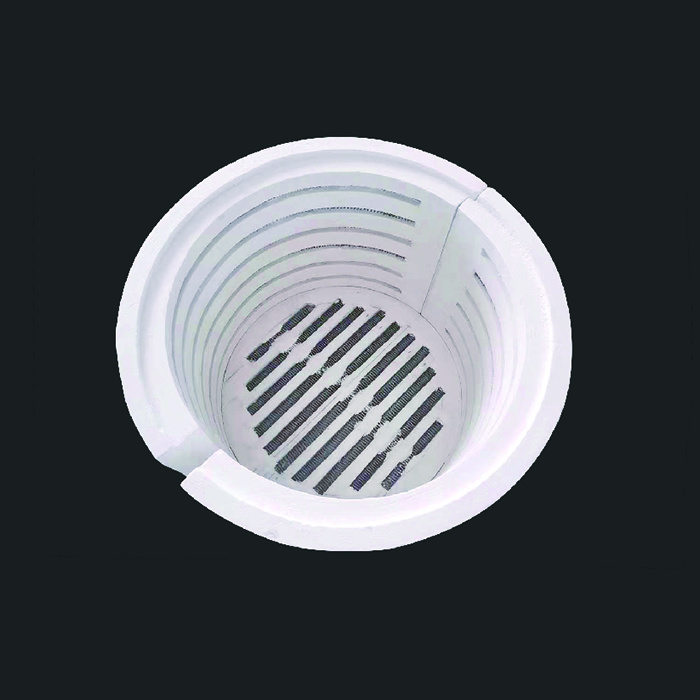Application Prospect of Ceramic Fiber
Release time:
2024-08-22 15:17
Compared with organic polymer membrane, ceramic membrane has many special advantages, such as heat resistance, solvent corrosion resistance, high mechanical strength, uniform and narrow pore size distribution, controllable microstructure, long service life, etc., so it can meet the particularly harsh requirements. It has a wide application prospect in petrochemical industry, chemical industry, metallurgical industry, food industry, green energy-saving engineering, new energy and other fields, and is receiving increasing attention. However, the practical ceramic membrane is generally asymmetric structure, the membrane preparation process is complicated, the manufacturing time is long, and the cost is high. In addition, the commercial ceramic membrane generally adopts a multi-channel tubular configuration, the thickness of the membrane tube is thick, and the packing density of the membrane is low, resulting in a small filtration area per unit volume and low separation efficiency.

In recent years, the new hollow fiber configuration ceramic membrane has been highly concerned, hollow fiber ceramic membrane in addition to the traditional ceramic membrane itself has the advantages of large filling density, large unit volume membrane separation area, thin membrane wall, high penetration flux and saving raw materials, easy to realize the miniaturization of separation equipment. The application of the new hollow fiber configuration ceramic membrane is expected to greatly improve the separation performance of the ceramic membrane. Because of its special performance and structural characteristics, hollow fiber ceramic membranes are receiving more and more attention in the application fields of inorganic separation membranes for wastewater (gas) treatment, solid oxide ceramic membrane fuel cells, micro-channel reactors, catalyst carriers and so on.
The new hollow fiber ceramic membrane has attracted great attention because of its special advantages such as high packing density, large separation area per unit volume, thin membrane wall, high penetration flux and raw material saving. It has hidden application prospects in porous and dense ceramic separation membranes, solid oxide fuel cells, microchannel reactors, catalyst carriers and so on. On the basis of summarizing the characteristics of hollow fiber ceramic membranes, the research progress of the preparation methods of hollow fiber ceramic membranes is reviewed, and the advantages and disadvantages of different preparation methods are analyzed and compared. Applying the phase transformation method to the preparation of hollow fiber ceramic membrane can realize the composite ceramic membrane with self-supporting asymmetric structure by one-step forming, which is beneficial to improve the membrane infiltration flux, simplify the membrane preparation process and significantly reduce the manufacturing cost.
In addition to the advantages of the ceramic membrane itself, the new hollow fiber ceramic membrane has the following prominent advantages compared with the traditional multi-channel or flat-plate membrane: high packing density, large membrane filtration area per unit volume, and easy to realize the miniaturization of separation equipment. The separation efficiency of hollow fiber ceramic membrane will be significantly improved than that of traditional ceramic membrane. The hollow fiber membrane tube wall is thin, so it can reduce the membrane infiltration resistance and shorten the infiltration path, improve the liquid infiltration flux. In addition, the membrane wall thickness is much smaller than the traditional tubular and flat ceramic membrane, can greatly save the powder raw materials. Hollow fiber membrane can be used according to the practical application needs of internal pressure type or external pressure type two different filtration methods.
The template method is based on the organic polymer hollow fiber or activated carbon fiber as the template, the first pre-treated template into the pre-prepared stable oxide precursor sol, through the dip coating method, in the surface of the fiber template to produce a layer of gel layer, followed by drying and high temperature firing to obtain hollow fiber ceramic membrane. When the hollow fiber ceramic membrane is prepared by the organic template method, the symmetrical or asymmetrical hollow fiber ceramic membrane can be produced according to the difference of the microstructure of the template. It is anticipated that the creation of an asymmetric configuration will help to reduce membrane penetration resistance and increase membrane water permeability.
Related News
What type of ceramic fiber blanket boiler insulation?
Recently, with the continuous progress of industrial technology, the selection of boiler insulation materials has become the focus of attention in the industry. Ceramic fiber blanket has attracted much attention because of its excellent thermal insulation performance and wide application fields. So, what type of ceramic fiber blanket should be chosen for boiler insulation? Let's take a closer look.
Boiler insulation material selection: ceramic fiber blanket model revealed
Recently, the discussion on boiler insulation materials is hot again, among which ceramic fiber blanket has attracted much attention because of its excellent thermal insulation performance and wide range of applications. So, what type of ceramic fiber blanket should be chosen for boiler insulation.
Based on the present, look to the future, the establishment of many varieties, different grades of refractory products.
Manufacturing process of ceramic fiber
There are three methods for making ceramic fibers: the spinning method, the blowing method and the spinning method. The ceramic fiber in the ceramic fiber paper is commonly used in the blowing method. The wire blowing method is to spray the molten mixed raw materials to the peripheral surface of the high-speed disc in a trickle state under the pressure of a rare gas. Under the pulling force of the high-speed rotation of the disc, it is spun into filaments and coiled on the disc to obtain ceramic fibers of several microns.

